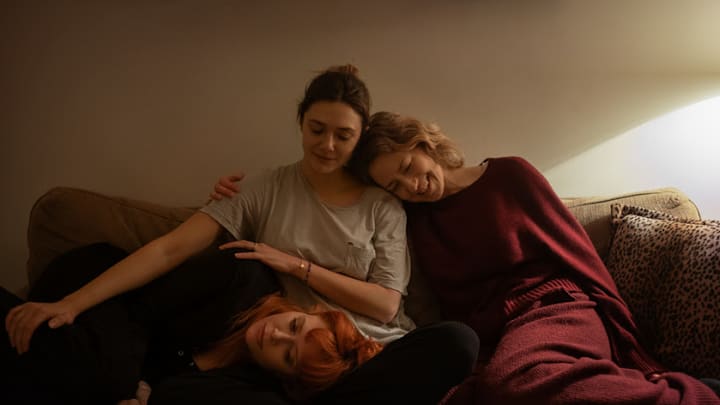"The hard truth is he's dying." These blunt words from Katie (Carrie Coon) immediately establish the tragic situation transpiring in His Three Daughters. Vincent, the father of Katie, Rachel (Natasha Lyonne), and Christina (Elizabeth Olsen), is slowly dying. Now in hospice care in his apartment, the three estranged siblings have reunited for Vincent's in his final days. Rachel has lived with and taken care of Vincent for years now. Now the firm Katie and gentle caregiver Christina are doing their part in their father’s final hours.
Weighing just as heavily on their minds, though, is how these three sisters have such a fractured relationship. They share a father, sure. However, vast differences in age and especially familial background (Vincent married Rachel’s mother when she was a kid, whereas Katie and Christina are his biological offspring) inform avalanches of strife between the ladies. Katie and Rachel especially are at each other’s throats all the time. Against this mournful backdrop, it’s time for Vincent’s three daughters to confront their problems. They also need to grapple with an inescapable dark quandary: can the trio have a relationship once dad dies?
In 2008, writer/director Azazel Jacobs delivered Momma's Men. This quasi-autobiographical Manhattan yarn concerned a man returning to his childhood home and refusing to leave. A little over 15 years later, Jacobs again explores adults coming back to their New York roots. Momma’s Men, though, concentrated on sealing oneself away from the modern world and adult responsibilities. His Three Daughters, meanwhile, sees an older Jacobs (now closer in age to Vincent than Christina) delivering a narrative about the unavoidability of time’s ceaseless march. Coming back to familiar surroundings under such bleak circumstances only exacerbates challenges between the three leads rather than insulating them from hardship.
The dialogue-heavy script Jacobs conjures up around this theme functions best as a showcase for its lead performers. Natasha Lyonne, for instance, demonstrates her chops with handling downbeat and quietly pain-ridden material. It’s so striking how Lyonne has such deeply idiosyncratic features as a performer (her voice and body language, namely). However, she effortlessly weaves new personalities from role to role. It’s a quality echoing early 20th century movie stars. Here, Lyonne uses tiny flickers of her eyes or her delivery of defiant behavior to Coon’s Katie to express the pain soaked into Rachel’s bones. Katie and Christina just got here. Rachel, meanwhile, has lived with watching her dad gradually pass daily for eons now. It’s a gut-wrenching reality Lyonne communicates in such devastating but not ham-fisted terms.
As for Elizabeth Olsen, it's a relief to see her in her first non-Marvel movie role in so many years. Even beyond that achievement, her work in His Three Daughters is remarkable. With Christina, Olsen’s tasked with lending tangible humanity to the calmer middle ground between Rachel and Katie. She’s the one who oozes affection for everyone, including her daughter back home. Other performers could’ve turned this character into a lovey-dovey caricature. Olsen instead injects her with such believability. Great touches like Olsen’s flurry of facial expressions after Rachel calls her character “weird” on a park bench lend such distinctive life to Christina.
Jacobs and cinematographer Sam Levy initially frame the three sublime performances anchoring His Three Daughters in tight, isolated terms. For the first half-hour of the feature, Rachel, Katie, and Christina rarely inhabit the same frame together. They're usually depicted alone center-frame in medium shots. Even if they're engaging in conversations with one another, one sister typically gets showcased on-screen at time. This visual motif’s most intriguing manifestation comes in a shot where Rachel and Katie technically occupy the same frame. In a single take, Katie comes to Rachel’s room, knocks, and the door opens a crack. The camera then tilts down, focusing on Rachel’s face as Katie berates her for smoking weed inside the house.
Rachel’s face and Katie are in the same frame…but not their faces. For this portion of the single-take shot, Katie’s body is only shown from the neck down. Once the door closes and Rachel is out of the shot, Katie’s face returns to the screen. Even in wider shots physically involving both sisters simultaneously, Jacobs emphasizes how these siblings are isolated from one another. Similarly, Vincent is kept largely off-screen, his absence from His Three Daughters quietly reinforcing hos far gone he is mentally. These framing choices, echoing Chinonye Chukwu’s isolation-informed filmmaking in Clemency, nicely accentuate the emotional gulfs between the inhabitants of this cramped apartment.
That’s one of the more intriguing visual details in His Three Daughters, which otherwise opts for standard framing with its dialogue-heavy narrative. Speaking of dialogue, the screenwriting from Jacobs functions best with emotionally jagged phrases. Katie and Rachel’s messiest interactions, for instance, really soar in depicting an authentically troubled sibling dynamic. Other more didactic pieces of dialogue feel incongruous to the rest of the proceedings. Jovan Adepo’s supporting character Benjy especially suffers from these problems. Even an actor as skilled as Adepo can’t make some of his character’s frank phrasing click into place.
Thankfully, the big emotional points in the His Three Daughters script are handled with delicate care. This includes a mesmerizingly bittersweet finale that, on paper, should be a syrupy mess. In execution, it's tremendously moving. Most importantly, His Three Daughters let us all revel in the prowess of Coon, Lyonne, and Olsen as actors. If there’s any reason you must see His Three Daughters ASAP, it’s to bask in their greatness. That or you’re an Azazel Jacobs die-hard fan eager to see him regain his creative footing after his 2021 misfire French Exit.
